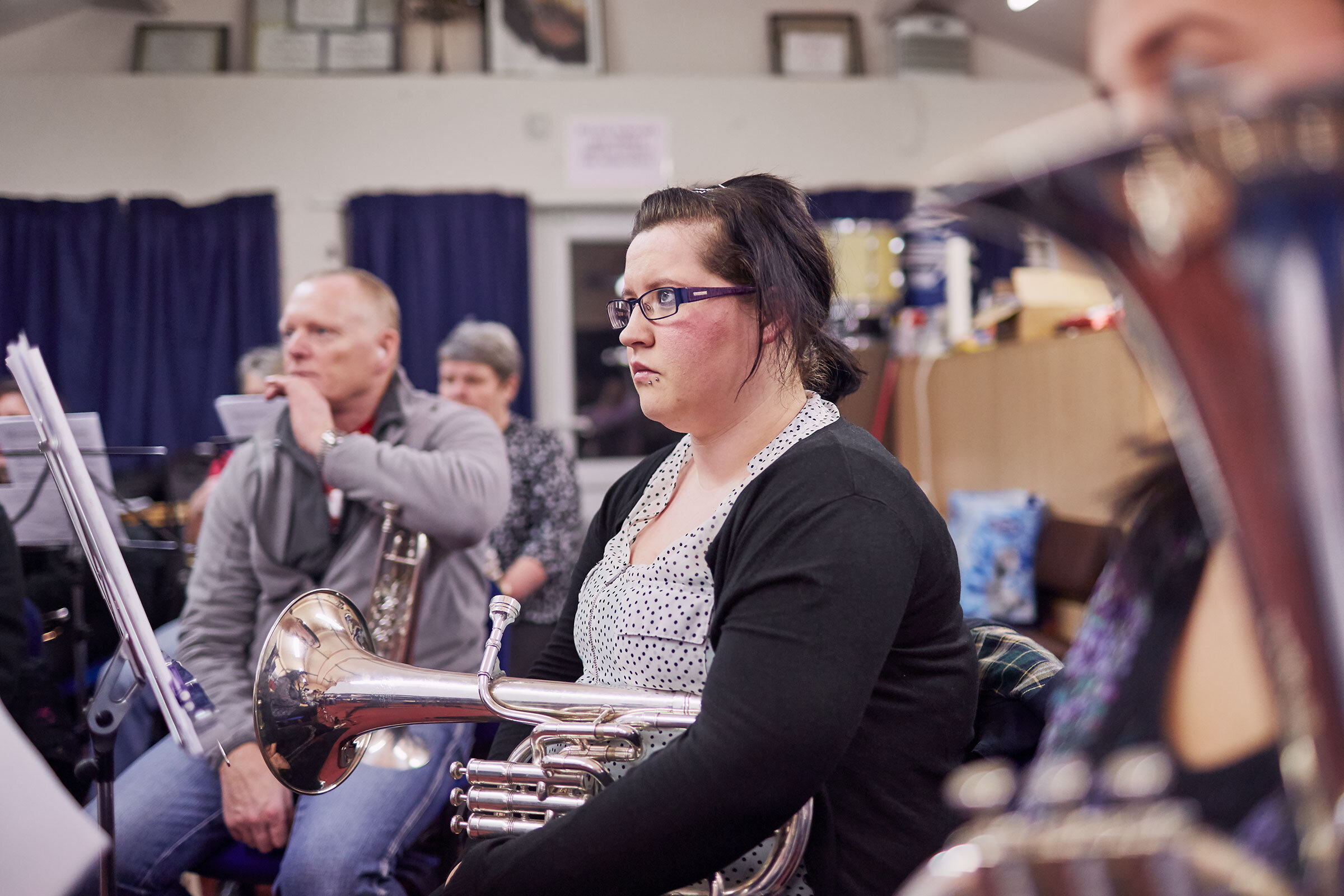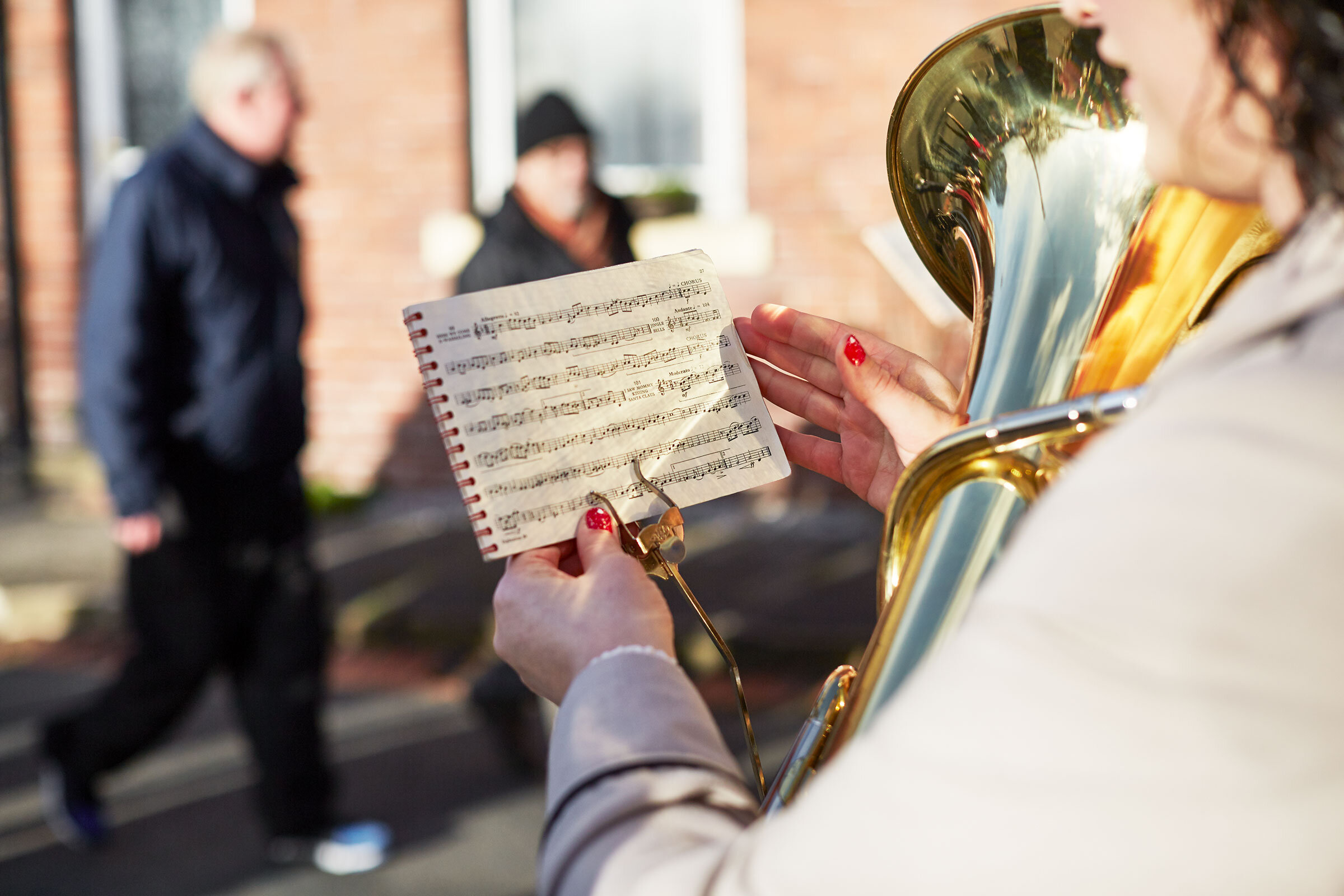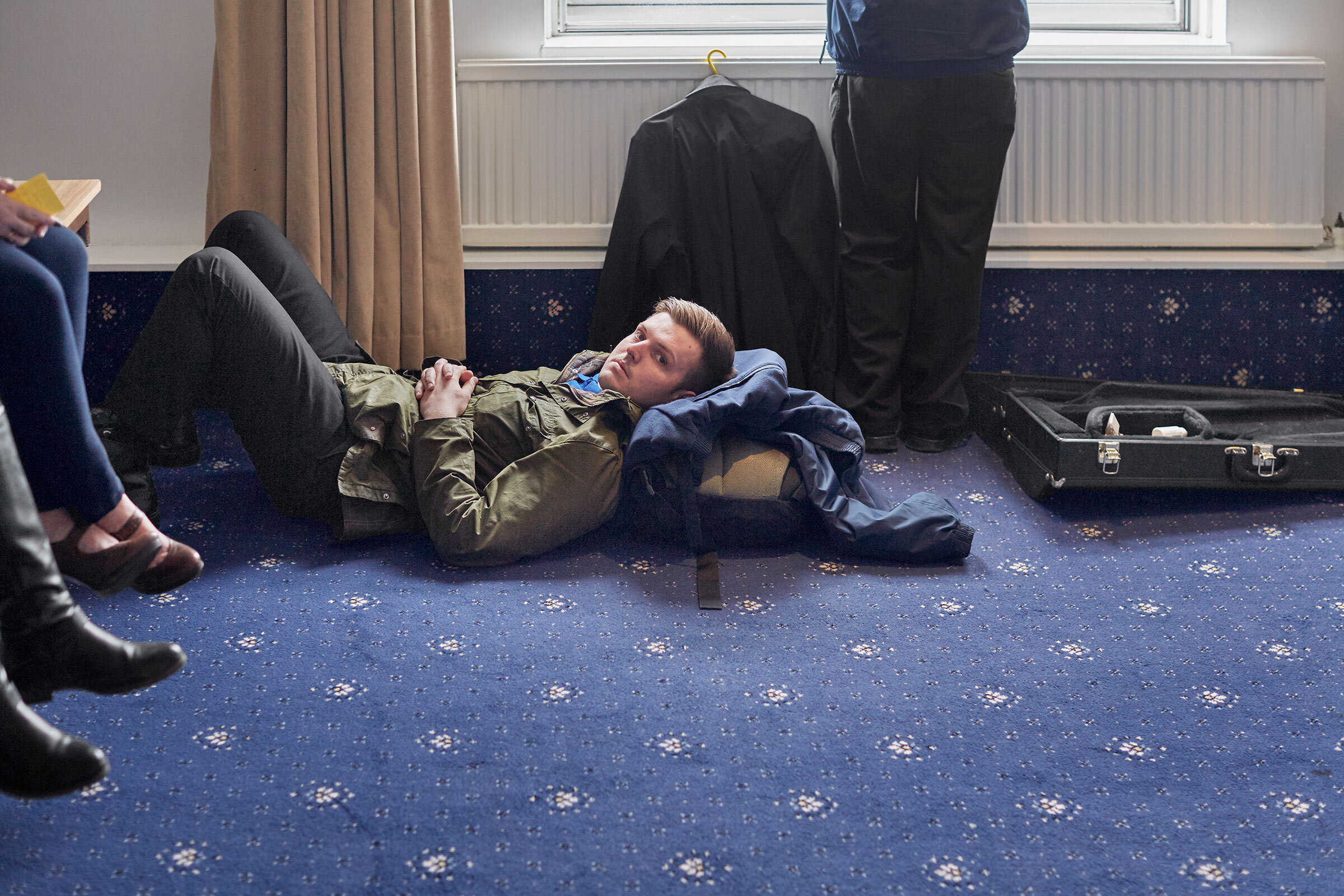Neither Work Nor Leisure
Documenting the multi-generational commitment and calling of a northern brass band
‘Find the gap in the hedge, after the graveyard and before the farmer’s field.’ I had my instructions, but it was a dark and rainy October night, with no street lights. With my heavy camera bag I pushed through a hedge, the wrong hedge, and trailed through the mud left by a hundred rainy days. This was the Pennines, a beautiful and sometimes brutal landscape scattered with small villages clinging onto the hillsides.
In the distance I could hear a warm and strangely familiar sound, a group of people tuning up their cornets, trombones, french horns and b flat basses, a friendly and comforting anticipation of music yet to come. I was transported back to my childhood, hearing the Nostell Colliery Band rehearsing at the Working Mens’ Club at the top of my street. But this was 30 years later and I hadn’t heard that for a long time.
After multiple missed calls, and torches shone in my direction, I arrived over wet grass to the band room and saw 28 people crammed into a space that struggled to accept even one more. This was the Old Silkstone Band I was to photograph over the next 16 months.
Brass Bands were part of the Industrial Revolution in the UK. There’s evidence to suggest that mining and mill employers, in a bid to decrease any political activity, funded the bands as a way to occupy the working class. That may be true, but it also gave them something to be proud of. By 1860, England had over 750 Brass Bands and a year later the Old Silkstone Band was born.
Between then and now, bands have played through all manner of events, engagements, funerals and political campaigns — the whole of life’s ups and downs accompanied by the dulcet and magnificent tones of a Brass Band, from birth until death.
And this is what struck me when I first walked through the band room door, dropping my camera bag on the well-worn carpet, soaked head to toe and covered in mud. I sat at the side of the players and looked down the row: we had a lady in her 40s, a girl of around
15, a man in his 50s and across the way, a euphonium player who I later learned was 83-year-old Les Turner who joined the band as a child.
Fast forward 16 months, 6am on a bitingly cold Saturday in a car park outside a closed school in Skegness. It’s the annual Butlins Mineworkers’ Brass Band Contest — a full weekend event. The band and I arrived last night. I tried and failed to keep up with the drinking and had half a sleep in a chalet. The band are about to go into a 3-hour rehearsal before heading back to Butlins to compete.
The dedication is unbelievable. This contest means more than anything else in the world to them. A great performance could win prize money and the band need some of that desperately. It’s a small amount of money that would just go back into the band to try and keep it afloat. This is not Maggie Thatcher’s capitalist England, this is a relic from a bygone age where community matters, and this contest means more than personal gain.
Leisa is the principal cornet player — the soloist. It’s the most pressured position in the band. From the lush and powerful throng of the ensemble, the solo should soar above and be the payoff the audience needs. Not only that, but its superb execution could also win the hearts of the judges. Leisa has a 2-year-old son and runs her own business making cakes for local events and weddings. A full-time job and a toddler is surely enough for anyone, but to add the huge commitment of a band as well seems super-human to me.
To join a Brass Band is no light endeavour, it’s not a job as there’s no financial incentive, nor is it anything like a light and breezy hobby. With upwards of 10 hours spent with the band every week, way more at many times of the year, as an outsider looking in, it can only be described as a calling.
But for Leisa, the hard work and the hours are worth it, the band is her social life:
‘All of my close friends I've met through brass bands. It’s just a really easy way to meet people, and you're seeing people at least a couple of times a week, and most weekends. In a lot of cases I've grown up with some of the friends I have in bands and they're more like family now than just friends.’
This level of community living is now lost to most of us. So rather than it being a chore
to finish an 8-hour day at work and then head straight to a 3-hour rehearsal, it’s like an extension of ‘home’ — familiar, fun, engaging, and at times frustrating and tense. Over
time they see marriages, births, fall-outs, make-ups, blossoming romances, and new friendships. They conquer hurdles thrown their way and celebrate the good times.
It goes even further than that. One of the longer-term members, Tracey, an NHS nurse who I never saw without a smile on her face for the whole 16 months, joined the band in 1990. She credits the band with helping her through bereavement and a divorce in quick succession:
‘My first marriage broke down in 1994 and ended up in divorce, it was a difficult time as I was still living in the same house as him for months but the band and friends helped me get through it, whether that was a chat, financially, picking me up for rehearsal and taking me to band jobs.’
Two years later, and with a young daughter, Tracey’s Mum tragically passed away:
‘She was 51, I was 28, not an easy time,
but again they were there for me every bit of the way through those early days. The band members’ wives, daughters, mothers and dads all helped look after Megan whilst I played at contests and concerts. I would never have been able to continue with the band if there wasn’t support there. She even called Ian’s [fellow band member’s] mother-in-law “Nana Ann”. This was from being a baby and they would support me and her now, all these years later.’
Of course, it can’t all be roses, and the bands face many challenges to survive. They need to ensure that the younger generations continue to get involved. It seems that it’s not a lack of interest that’s proving tricky, but with school funding at an all-time low and the over-bearing emphasis on Maths and English, schools can’t teach the arts in the same way, nor justify the expense of the instruments.
There are small amounts of funding here
and there, but nothing like the government funding that keeps the opera and ballet afloat. Many people enjoy the opera and ballet, all the performers, musicians, costume makers and technicians get a wage – it’s a good thing. Meanwhile the 400+ Brass Bands in the UK today (which is over 11,000 people) provide a huge amount of social, educational and artistic benefits across the country, which all feeds into healthy self-esteem and long- term happiness. Could its lack of funding be because it’s a working-class art, 200 miles away from the decision-makers? Luckily there are organisations like Brass Band England who are doing much to rectify this.
In my time photographing the band, they lost their long-term band room through some dispute with an aggressive new land-owner, and they didn’t have the money to fight it in court. They had to quickly vacate the pre-fabricated building that they’d paid for themselves and built in 1980. As the land-owner had put barbed wire around the building, this involved a military style operation to get in and out. It was clearly a sad time, but the band had obviously come to some unspoken agreement to not let it beat them.
I helped retired engineer and percussionist David rummage through some old forgotten boxes, unearthing old photographs from when his Dad was the band leader in 1968 and numerous other memorabilia. As with everything I experienced with the band, nothing was going to get in the way of working hard on the music, and playing hard at every opportunity.
I get lost on my way to the finals of ‘The Brass Factor’ contest in Holmfirth and
end up driving over the bleak and desolate Holme Moss down into the Holme valley. It’s absolutely beautiful, but I’m hoping my car doesn’t break down up here. The hills stretch far and wide with Manchester, Sheffield and Bradford along the edges. It’s epic, brutal and somehow perfectly aligned with the lush, majestic and emotive sound of a Brass Band and the towering old mills that still dominate the towns and villages. I would be hearing many bands tonight, each playing 20 minutes of music, in the hope of winning the contest.
With a new band room to find, a lot was riding on a faultless performance from Old Silkstone Band. Their pieces were chosen to show range and technical prowess, particularly Leisa’s cornet solo on ‘Angels Prayer’.
This piece is both slow and in a higher range, and as Leisa told me:
‘Slower pieces can be more difficult than faster ones a lot of the time as they’re more exposed and it’s not as easy to disguise mistakes.’
I wasn’t the official contest photographer and therefore not allowed backstage, but by picking up a trombone case, putting my hat on and keeping my head down I made it past the angry security guard. A band played on the stage and Old Silkstone Band waited in the wings, utterly silent and utterly focused, I shot a few frames before sensing that for once I wasn’t so welcome. I made my way up to the rafters to watch from there. From my limited experience they sounded fantastic, but then by this point I was definitely biased.
Three hours later in a local curry house in a Yorkshire stone terrace, the atmosphere is jubilant. The band came 2nd and Leisa won Best Soloist.




















































